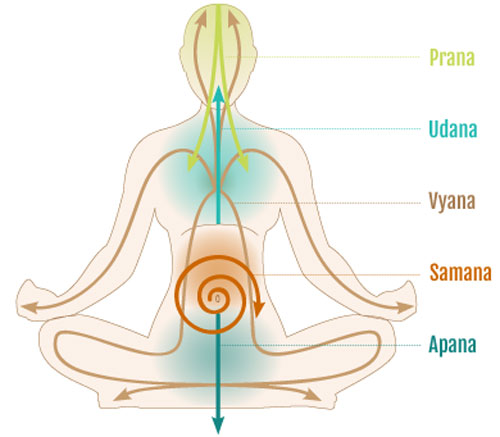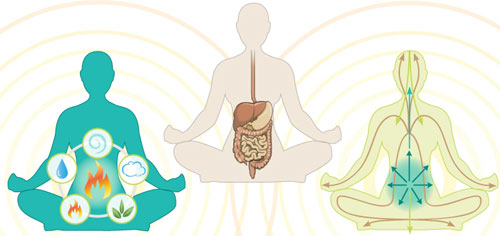Few short information about the manifestation of Vayu in the human being according to Hindi tradition
There is a pure limitless energy that flows in each and every one of us and exists everywhere around us. This energy is called prana, and it is carried through our bodies through something called a vayu. Vayu translates to ‘wind,’ and vayus are responsible for transferring energy throughout the body.

Although vayus are subtle, they have a huge impact on how our bodies feel, so learning to move with their natural rhythms is vital for our health. So take a moment to reconnect with yourself by exploring the energy within you and aligning the consciousness and body with the world around you.
Here’s what you need to know about each of the five vayus:
1. The prana vayu
The prana vayu is an inward-moving force that brings vital energy to our bodies and minds. Everything we take in – from the air we inhale to the food we consume and the thoughts and emotions that we feel – is brought into us with the prana vayus.
Its energy pervades the chest region, allowing our heart and lungs to take in new life energy. This vayu allows us to see the world in all its glory and motivates us to see and take action for all of life’s possibilities.
Practicing pranayama and heart-opening asanas will get these prana vayus flowing. If you want to connect with prana vayu, practice bow pose, camel pose, cobra pose, dancer pose, and bridge pose.
2. The apana vayu
The apana vayu governs the downward and outward flow of energy in our bodies. Apana energy nourishes the organs of digestion and reproduction, it is situated in the pelvic floor.
Since it is situated in the pelvic floor, its energy pervades the lower abdomen. What we release and let go of in life and in our bodies is just as important as what we receive and take in. The balance of the prana and the apana vayus is the key to having a healthy mind and body. If we release too much, there will not be enough to nourish us. And if we hold everything in, it can become toxic.
Much like breathing, we need to find the balance of allowing new life energy in with each inhale and releasing anything that no longer serves us with each exhale. To activate your apana vayu, focus on rooting down in standing poses such as forward folds, which will bring a release to the mind and fill it with a sense of purpose.
You can also try seated forward fold, spread-legged standing forward bend, tree pose, and bound angle pose.
3. The samana vayu

The samana vayu unites the upward energy of prana and the downward energy of apana. Here, the inner winds of the upper and lower body meet at the abdomen. Like a whirlpool of converging energy, our samana vayu churns around the navel while digesting all substances: food, air, experiences, emotions, and thoughts.
Samana creates a powerhouse in our core, where we can find balance on and off the mat. Our self-confidence arises from this fire of converging energies, giving us the motivation for real transformation.
In our practice, we can activate this life energy by focusing on twists and abdominal work, which will neutralize and fire up the core. Find your center and know all of that power with poses like revolved side-angle pose, crow, chair pose, reclining abdominal twist, and boat pose.
4. The udana vayu
Udana vayu is the upward-moving breath, which directs the flow of prana from the lower to the higher planes of consciousness. The udana vayu is very important to your spiritual practice, as it brings prana to the energy centers deep in your brain and the central axis of your subtle body. This energy is most active between the heart and the head and rules the throat center.
This vayu governs speech, expression, and your growth and metabolism through the thyroid glands. The udana vayu is an ascending force, including poses that direct energy to the head, neck, and upper back, and poses that turn the body upside down are good for activating the udana.
Just like a well-rounded practice, we warm up the body and often end with an inversion, so we connect with prana vayu to go inward, apana vayu to anchor, samana vayu to unite them, and finally udana vayu to ascend the consciousness and body toward a state of deep relaxation and meditation.
To connect with the udana vayu, go for fish pose, headstand and shoulder stand.
5. The vyana vayu
We’ll end our vayu series with the fifth inner wind called vyana vayu, which integrates and balances all of the vayus and is called the ‘omnipresent air.’ Vyana’s expansive and nourishing energy governs all of the movement in our muscles and joints, bringing our bodies to life with motion.
This vayu dictates the blood flow and the electrical impulses through our nervous system and the movement of fluid through the lymphatic system. Standing poses are particularly beneficial because they involve movement of every part of the body, from the center outward.
As we bring awareness to the expanding energy traveling outward through the body, our minds can drift inward to the source of all prana. We can never master all of the magical energy running through us, but we can try to be aware of how energy is running through us and know that we can tap into this life force. Understand where your energy is taking you and how it is affecting those around you.
yogaesoteric
July 19, 2019
Also available in:
 Français
Français
